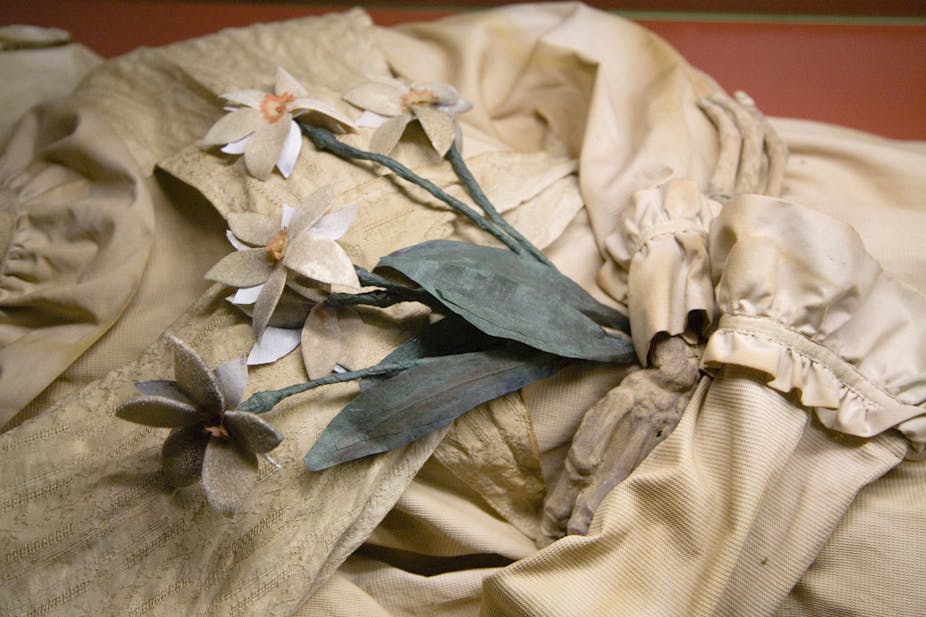In 1994, a crypt containing 242 bodies was discovered in Vác, Hungary. Many of the bodies were naturally mummified, including the remains of a woman, Terézia Hausmann, who died apparently from tuberculosis. Because of the natural preservation of these remains, we could extract and type the DNA from the bacterium, Mycobacterium tuberculosis, that had infected her. This has revealed important information about these bacteria that infected people 200 years ago.
The mummies, when carefully analysed, reveal key data about the lineages of M. tuberculosis that infected people then. It is important we understand how M. tuberculosis has changed over time as new strains are developing that are more dangerous. Some are spread more easily from person to person, and others are resistant to most, if not all antibiotics.
Today two-thirds of the global human population is infected with M. tuberculosis but only 10% will ever develop active tuberculosis (TB). This is a sign that this disease has co-existed with humans for thousands of years. Such co-existence, we believe, has led to evolution of humans and M. tuberculosis, so that different human populations from around the world are likely to have a particular strain or lineage of M. tuberculosis.
These mummified bodies found in the town of Vác were in a sealed crypt in an 18th century church, that was found to be full of coffins. Most bodies were totally or partially naturally mummified, because of local environmental conditions. Church and civic archives made it possible to identify many individuals and to discover their family relationships, date of death, age at death, occupation, and sometimes even a record of symptoms before death.
Analysis of tissue and bone samples confirmed that over 60% of the mummies had TB and in some cases the DNA was extremely well preserved. TB then was widespread in Europe as it is linked to the population density and at that time people were moving into towns and cities.
TB is mainly a lung infection, so the human population density is important because this increases the transmission of bacteria from person to person via their breath. With data from Hungarian archive, a correlation between transmission rates based on population density could be determined too. Also, at this time in history there was no effective treatment, so people only survived if they had good natural resistance.
Scientists can estimate the rate of change in M. tuberculosis over time, based on the chances of genetic mutations and rearrangement occurring in the bacterial genome. However, palaeomicrobiology – the study of ancient microbes via their DNA and other such markers – enables researchers to examine historical and archaeological material directly. This provides calibration in real time of when particular genetic changes occurred.
Although DNA can be damaged by reaction with oxygen, water and enzymes produced during the natural decay process after death, sometimes the local conditions enable both human remains and their infecting bacteria to be very well preserved, as was seen in the Hungarian mummies.
Whole Genome Sequencing, or metagenomics, is a technique that examines all DNA in a sample. DNA fragments are tagged, sequenced and analysed using specialist software. Our work published this week in the New England Journal of Medicine was a metagenomic study based on lung tissue of Hausmann, who died on 25 December 1797, aged 28 years.
Our analysis reveals that the bacterial DNA was much better preserved than the human DNA. At first this may seem surprising, as the TB bacteria would not be evenly distributed in its human host, and during life its DNA would be very much in the minority. However, M. tuberculosis has a very tough cell wall. It is rich in lipids and we know that it can persist in the bones of its host for thousands of years. In comparison, human DNA readily degrades as it has no such resistant cell wall to protect it.
Hausmann was infected with two strains of M. tuberculosis. Both strains resembled the Haarlem lineage of M. tuberculosis, specifically, a clone of the lineage that appeared to spread preferentially in modern-day Germany.
The importance of this work is that it enables us to compare strains of M. tuberculosis from 200 years ago with those of today. In the 18th century there was no effective treatment for TB as it was in the pre-antibiotic era. However, the population in Vác included some individuals who had localised evidence of infection but who lived to a considerable age. The comparison of ancient DNA of both M. tuberculosis and also the human population, who had either active or latent infections, may shed light on genetic factors involved in how TB spreads or how it develops resistance.

